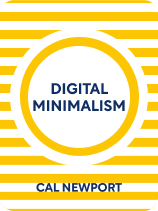

This article is an excerpt from the Shortform book guide to "Digital Minimalism" by Cal Newport. Shortform has the world's best summaries and analyses of books you should be reading.
Like this article? Sign up for a free trial here .
What is digital minimalism? How can adopting the lifestyle of digital minimalism help you connect with your values and live a happier, calmer, and more fulfilling life?
Digital minimalism is a term introduced by Cal Newport in his book “Digital Minimalism: Choosing a Focused Life in a Noisy World.” But what is digital minimalism exactly and how do you put it into practice?
In this article, we will provide a brief overview of what digital minimalism is and discuss the central principles of this philosophy.
What Is Digital Minimalism?
A growing number of people are preaching the benefits of pulling back from the total technology immersion that has become the default for many. Those who promote reducing technology use typically advise simple hacks like turning off notifications, but such simple strategies don’t address the root of the problem for most people.
Instead of hacks, most people need a complete overhaul—and that starts with developing a philosophy of technology use. Digital minimalism is one such philosophy. Digital minimalism requires that you identify what values and activities are priorities in your life, determine which digital tools promote those priorities, and implement constraints for using these tools to maximize their benefits and minimize their harm and distraction.
So, what is digital minimalism? Let’s explore its three main principles.
Principle #1: Eliminate Clutter
Main idea: When your life is cluttered with too many digital tools, they collectively demand so much of your time and attention that the negative effects outweigh the benefits of any single tool.
Explanation: Most people’s digital use follows a maximalist philosophy, which suggests that you should adopt a digital tool if it provides any benefit at all. By contrast, the minimalistic approach requires you to constantly weigh the pros and cons. Digital minimalists assess technology with cost-benefit analyses, which involve asking yourself:
- Does this technology add value to my life beyond minor convenience?
- Is this particular technology the best way to support my values?
Consider how you might apply this assessment to Facebook and Twitter:
- Facebook may be an easy way to keep up with family and friends, but is it the best way? You may get more value by quitting Facebook and using that time instead to talk to friends and family on the phone, or meet them for coffee.
- You may use Twitter to keep up with news headlines and expose yourself to different ideas and perspectives—but you spend an hour or two a day sifting through fluff to find that high-quality content. A more efficient alternative would be to use one reliable source for daily news headlines, and attend one informative talk or event each month.
If you assess every digital tool with these criteria, you’ll likely end up reducing or eliminating your need for these devices, even though our culture considers many of them necessary. As you realize all the things you’re gaining (like the opportunity to have meaningful conversations with friends over coffee), it’ll be easier to accept the things you’re losing by reducing your tech use (like hitting the “Like” button on a photo of a high school classmate).
Henry David Thoreau explores the idea that less is more in his well-known book, Walden, which is about his experience living modestly in a cabin in the woods for two years. In his experiment, Thoreau was testing a new economic theory that having more stuff doesn’t create a richer life. During his time in the woods, Thoreau added up the costs of building and living in his cabin, and then determined that he would need to work just one day a week in order to cover his expenses. Although it seems straightforward, Thoreau was radical in finding a way to weigh these two different measurements against each other: time and money.
Before Walden, economic theory focused on earning the highest profit possible. By contrast, Thoreau’s exchange rate between time and money enabled him to determine the cost of items not just in dollars and cents, but also in the amount of life that had to be sacrificed to earn those dollars. This explained why many people who followed the standard approach to earn as much as humanly possible seemed no better off for it: The time and effort they put in to earn those profits—and the things they necessarily had to sacrifice to do so—were greater than things they bought with those profits. For example, the nice Venetian blinds you bought with a big paycheck are not worth the life you missed while working weekends in order to earn that paycheck. Thoreau argued that even when money was spent on more practical items, like a wagon, the time saved by taking the wagon to town instead of walking did not outweigh the hours of labor spent earning the money to buy it.
Principle #2: Optimize Your Technology Use
Main idea: Digital minimalism isn’t just about eliminating technologies—it’s about selectively deciding which tools you’ll continue to use, and how you’ll use them.
Explanation: The second principle of digital minimalism applies the economic law of diminishing returns, which says that increased input leads to increased output up to a point, after which the benefits of additional input plateau. In other words, if you are overseeing a project at work, four people will get it done more quickly than two people, but nine people won’t finish it much sooner than four people. When it comes to technology, a few apps and devices may make your life more convenient, but too many will bog you down. Later in this summary, we’ll talk more about how to decide which tools to lose and which to keep.
Once you’ve decluttered your digital life and pared down your apps and devices, you must then decide how you’ll use them in order to get the most benefits with the fewest distractions. Instead of looking at an app or device as a single tool, think about it as a collection of features, such as direct messaging and marketing platforms. With this view, you can optimize your digital use based purely on the tools they provide, and it’ll be easier to bypass the rest of the noise.
For example, if you’re part of a group that uses Facebook as a primary means of communication, you can:
- Eliminate all of your friends besides those in the group.
- Bookmark the notifications page, so that you can check for updates while bypassing the news feed, which easily becomes a rabbit hole.
- Mute updates from the people you follow, so that your news feed is empty.
Additionally, if you use Netflix instead of cable because it’s cheaper and doesn’t have commercials, but you find that you are prone to binging, you can:
- Set a limit of two episodes per sitting.
- Make a rule that you only watch with other people, so that you incorporate social time.
Principle #3: Taking Control Is Empowering
Main idea: In addition to the direct benefits of reducing digital clutter in your life, the act of making deliberate decisions about your technology use helps you to reclaim the autonomy that many people feel they’ve lost.
Explanation: As we discussed in Chapter 1, one of the most harmful effects of technology addiction is that users feel they don’t have control. You can avoid all of the issues that come with technology overuse—including negative impacts on your psychological well-being and reduced time for other activities—if you can simply control your digital habits. Additionally, the act of reclaiming control of your time and attention is empowering, and in the coming chapters we’ll talk about the added benefit of using that time to engage in fulfilling activities.
Contrary to their reputation for Luddism, the Amish are not opposed to technology entirely—rather, they live out the principles of digital minimalism, especially as a growing number pursue entrepreneurship over farming. Most Amish communities have an “alpha geek,” who goes before the parish bishop to ask permission to try new technologies. With that permission, the first adopter tries out the technology and determines whether its use would support or undermine the community’s values, such as strong family and community relationships. If the technology’s effects are positive overall, the community is allowed to adopt it—if not, it’s banned.
This process has led many Amish communities to ban personal phones but provide a community phone booth, and to allow sophisticated farming equipment but to power machines with solar panels and diesel energy instead of connecting to the electric grid. Mennonites take a similar approach, though individuals make their decisions on a personal level, rather than following community mandates. Both communities share the minimalistic philosophy of prioritizing intention and commitment to their fundamental values above mere convenience.

———End of Preview———
Like what you just read? Read the rest of the world's best book summary and analysis of Cal Newport's "Digital Minimalism" at Shortform .
Here's what you'll find in our full Digital Minimalism summary :
- Why you're addicted to technology (and how tech companies feed your addictions)
- How a focus on social media is bad for real-life relationships
- How to transform your tech habits to get the best benefits without the drawbacks






